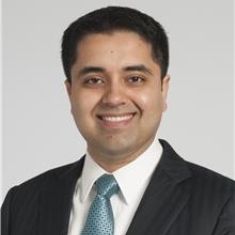Article
Study Warrants Screening for Both Eyes in DME Patients
Author(s):
An interview with a Cleveland Clinic investigator on adjusting macular edema screening methods.

Sumit Sharma, MD
A new paper presented at the American Society of Retina Specialists (ASRS) 2020 Virtual Meeting this weekend gave credence to the practice of screening both eyes of a patient with diabetic macular edema (DME).
The findings, presented by Sumit Sharma, MD, of the Cleveland Clinic, show that nearly half of all observed patients with DME in 1 eye from a pair of clinical trials would eventually develop DME in their other eye.
How this impacts the standard of screening and care for the space is not immediately known, but it gives Sharma and colleagues ideas for what retina specialists can do with these findings.
In an interview with HCPLive® following ASRS 2020, Sharma discussed the meeting, his team’s assessment, the impact it has on DME care, and how retina screening has been influenced by current circumstances of telemedicine.
HCPLive: First and foremost, Dr. Sharma, how are you doing?
Sharma: I'm doing great. Thanks for having me. I'm happy to be here.
HCPLive: Thank you so much for joining us. And we hope you enjoyed the sessions this weekend; it seemed to go without a stitch.
Sharma: Yeah, the format was very interesting. I really enjoyed the talks being posted live beforehand, and then focusing mostly on discussion with brief summaries of each talk. I think that was a very interesting method to take, and it allowed for it to be much more interactive than a lot of the other virtual meetings have been.
HCPLive: Let's just dive into the details right now. What were the most impactful findings from your team's study?
Sharma: So, what we aimed to do was look at how often eyes that don't have DME in one eye but do in the other, how often does that other eye, and how quickly does it develop DME? And what are the risk factors for developing DME?
So we looked in the VIVID and VISTA studies, which were randomized, phase 3 clinical trials, looking at treatment of DME over time with aflibercept and/or laser photocoagulation, and then looking at the fellow eyes in those groups. What we found overall was that about 44%, almost half of patients, develop DME in their fellow eye by week 100.
And there was a number of risk factors that were important that we identified as being causative or associative in developing DME, and those included the duration of having diabetes, the visual acuity level in the study eye, the DRS-S score in the study eye, the overall retinal thickness in the study eye, and whether or not the patient was taking insulin.
And of those, the 2 that really came out in the multivariate analysis as being the most important and the most pertinent were how long they had diabetes—so shorter duration of diabetes and having DME in 1 eye made you more likely to get DME in the other eye— and having a thicker retina in the 1 eye that has diabetes was associated with getting diabetes DME in the other eye as well.
The number of these risk factors that you had also increased your overall risk of developing DME.
HCPLive: That actually does feed into some of the discussion we had more, directly pertinent to diabetic retinopathy and diabetic patient risks, that we covered this weekend—in terms of stressing the need in identifying biomarkers that would indicate severity, less so than just prevalence. Is that where you see the trend right, now in terms of screening, that we're diving a little bit more into those specifics?
Sharma: So I think this really highlights the point that patients that you're treating 1 eye for, you've got to make sure you're also examining the other eye. You can't fall into this, 'We're just treating the treatment eye, just keep treating that, an ignoring the other eye.' Because even if their vision remains good, the incidence of developing DME in the other eye is very high over 2 years—almost 50% of these eyes.
It also really highlights for me that you don't necessarily have to treat these other eyes that don't have DME, because a number of other studies that we have out there show that if they have good vision—and even if it's mild DME or no DME—you can really monitor those. And as long as you're monitoring them very closely, I think that is the correct approach, and this really helps validate that, in my mind.
HCPLive: Is there guidance that conflicts these findings? Or is it a matter of clinician adherence to guidance?
Sharma: There's not really any good guidance, in terms of how often to see patients where you're treating 1 eye. It's that our schedules often become so busy, and especially during the COVID-19 time, a lot of people have switched to these injection-only visits to try to streamline the appointment for the patient, or not doing imaging, or cutting out some of the essential parts of the visit that we would consider essential prior to COVID. During COVID, we were trying to really streamline that.
And this is just a reminder that we've really got to be cognizant that the other eye has to be examined or at least imaged. And that may be the valid approach: go ahead and image both eyes if you're treating one, and just check the imaging if you're not going to necessarily examine them both every single visit.




